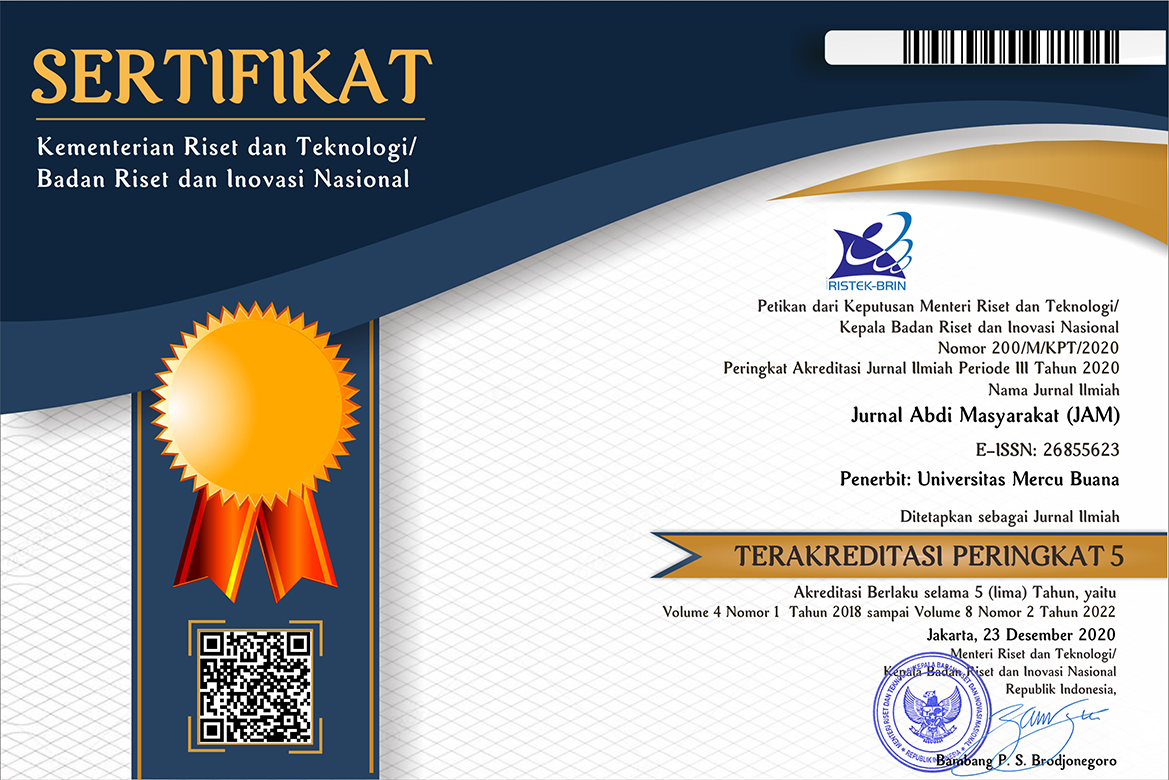Hydroponic Business Diversification: Health Detox Drinks In Improving The Economy And Food Security Of Urban Communities In South Meruya
Abstract
One way to reduce greenhouse gas emissions is by reforestation. Reforestation that can provide benefits for South Meruya residents who have limited land can use the Hydroponic method to grow crops. In order for the buying and selling power of hydroponic vegetables to increase, it is necessary to develop the business by increasing the types of products derived from hydroponic harvests, namely health detox drinks, to improve the economy and family food security. This activity is designed holistically to introduce the public to the concept of the importance of business diversification to find product ideas that can be developed from existing resources, calculate cost and selling prices, create attractive product packaging with halal guarantees, and market products online through media. social and marketplace. Potential that can be developed by partners includes the willingness of South Meruya PKK women, internet networks, awareness of entrepreneurship, increased demand for healthy food and drinks, especially hydroponic vegetables and derivative products, health detox drinks. In the end, this activity is expected to improve the economy of the urban communities targeted by the activity.
Keywords
Full Text:
PDFReferences
Ansoff, H. I. (1965). Strategies for diversification. Harvard Business Review, 5(2), 113–124. https://doi.org/10.1016/0024-6301(72)90048-9
Asih, D., Soelton, M., Tkhorikov, B. A., Ratnawati, K., Puspaningrum, A., & Ramli, Y. (2022). SUSTAINABLE PRODUCT : ENDLESS CAMPAIGN FOR A HEALTHY LIFE. International Conference on Community Development, 4(1), 334–338.
BMKG. (2021). Aktivitas Manusia sebagai pendorong utama peningkatan Gas Rumah Kaca. Buletin Gas Rumah Kaca, 1(1), 4–9.
Keatinge, J. D. H., Yang, R. Y., Hughes, J., Easdown, W. J., & Holmer, R. (2011). The importance of vegetables in ensuring both food and nutritional security in attainment of the Millennium Development Goals. Food Security, 3(4), 491–501. https://doi.org/10.1007/s12571-011-0150-3
KLHK. (2022). Profil Indek Kualitas Lingkungan Hidup.
Le, H. (2019). Literature Review on Diversification Strategy, Enterprise Core Competence and Enterprise Performance. American Journal of Industrial and Business Management, 09(01), 91–108. https://doi.org/10.4236/ajibm.2019.91008
Mun, C., Kim, Y., Yoo, D., Yoon, S., Hyun, H., Raghavan, N., & Park, H. (2019). Discovering business diversification opportunities using patent information and open innovation cases. Technological Forecasting and Social Change, 139(September), 144–154. https://doi.org/10.1016/j.techfore.2018.11.006
Nicolai, J. (1997). The Resource-Based Perspective: An Assessment and Diagnosis of Problems (No. 97-1).
Prasojo, M. (2017). Peluang Bisnis Sayuran Hidroponik dan Strategi Pemasarannya – Unsurtani.com. Unsurtani.Com. https://unsurtani.com/2017/04/peluang-bisnis-sayuran-hidroponik-dan-strategi-pemasarannya
Rumelt, R. (1982). Diversification Strategy and Profitability. Strategic Management Journal, 3(4), 359–369.
Schnitzler, W. H. (2013). Urban hydroponics for green and clean cities and for food security. Acta Horticulturae, 1004(September 2012), 13–26. https://doi.org/10.17660/ActaHortic.2013.1004.1
Seo, W., Yoon, J., Park, H., Coh, B. youl, Lee, J. M., & Kwon, O. J. (2016). Product opportunity identification based on internal capabilities using text mining and association rule mining. Technological Forecasting and Social Change, 105, 94–104. https://doi.org/10.1016/j.techfore.2016.01.011
Setiany, E., Hidayah, N., Briandana, R., Hidayat, M. S., Raihan, A. D., & Putri, T. A. (2023). Peningkatan Perekonomian Keluarga Urban Melalui Budidaya Sayur Hidroponik. Junal Abdi Masyarakat, 9(September), 1–9.
Siregar, D. I., & Binangkit, I. D. (2021). Business Value-Added Within the Circular Business Model: a Multiple Case Analysis. Jurnal Aplikasi Bisnis Dan Manajemen, 7(1), 231–239. https://doi.org/10.17358/jabm.7.1.231
Yoon, J., Park, H., Seo, W., Lee, J. M., Coh, B. youl, & Kim, J. (2015). Technology opportunity discovery (TOD) from existing technologies and products: A function-based TOD framework. Technological Forecasting and Social Change, 100, 153–167. https://doi.org/10.1016/j.techfore.2015.04.012
ZHOU, Y. M. (2011). SYNERGY, COORDINATION COSTS, AND DIVERSIFICATION CHOICES. Strategic Management Journal, 32, 624–639. https://doi.org/10.1002/smj
DOI: http://dx.doi.org/10.22441/jam.v10i1.25707
Refbacks
- There are currently no refbacks.
Copyright (c) 2024 Jurnal Abdi Masyarakat (JAM)

This work is licensed under a Creative Commons Attribution-ShareAlike 4.0 International License.
Indexing by :

|
|

|

|

|

|

|

This work is licensed under a Creative Commons Attribution-ShareAlike 4.0 International License
Jurnal Abdi Masyarakat
Pusat Pengabdian Pada Masyarakat
Jl. Raya Meruya Selatan, Kembangan, Jakarta 11650
Tlp./Fax: +62215871335
p-ISSN: 2460-352X
Online-ISSN: 2686-5623
http://publikasi.mercubuana.ac.id/index.php/jam








